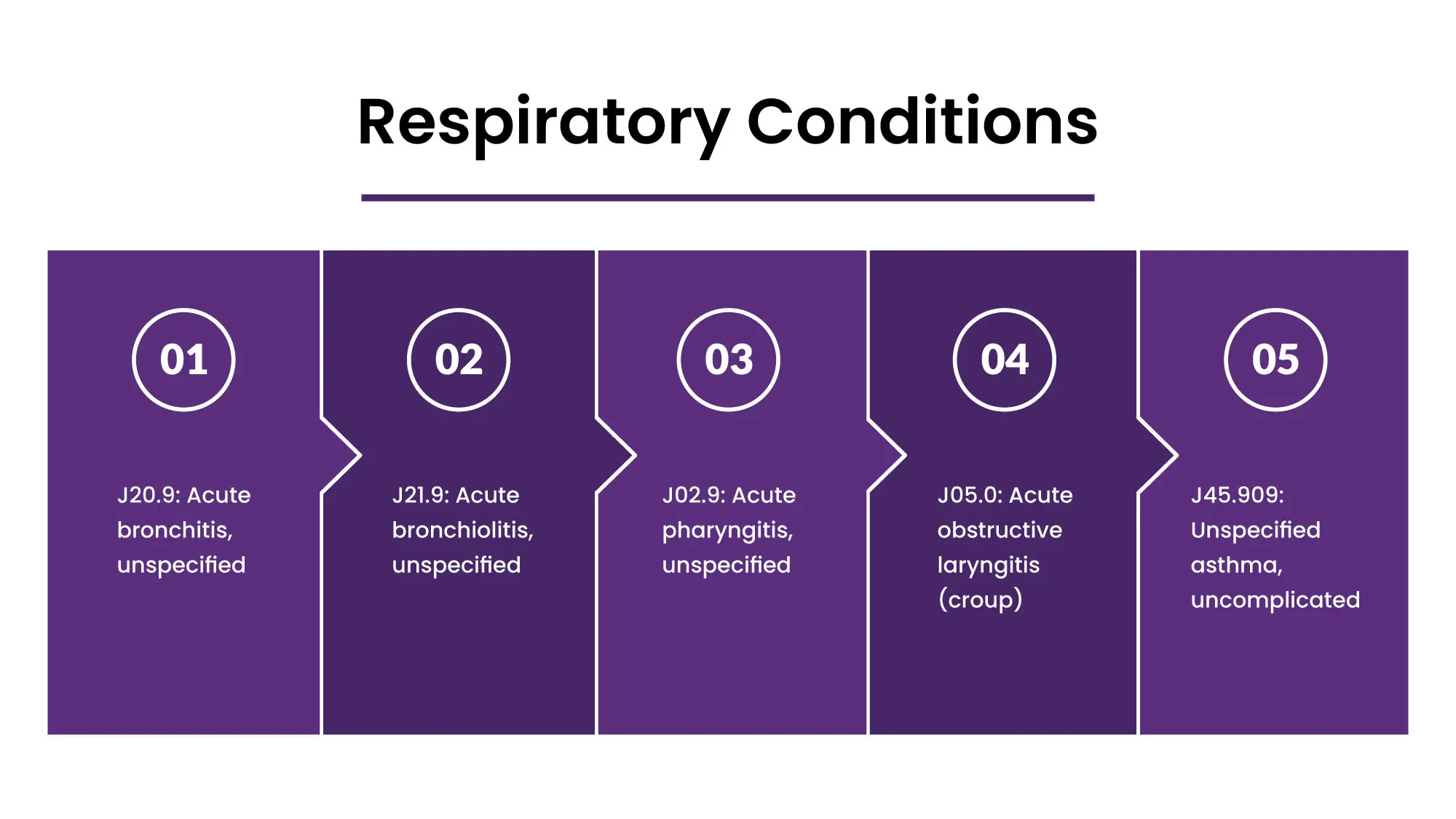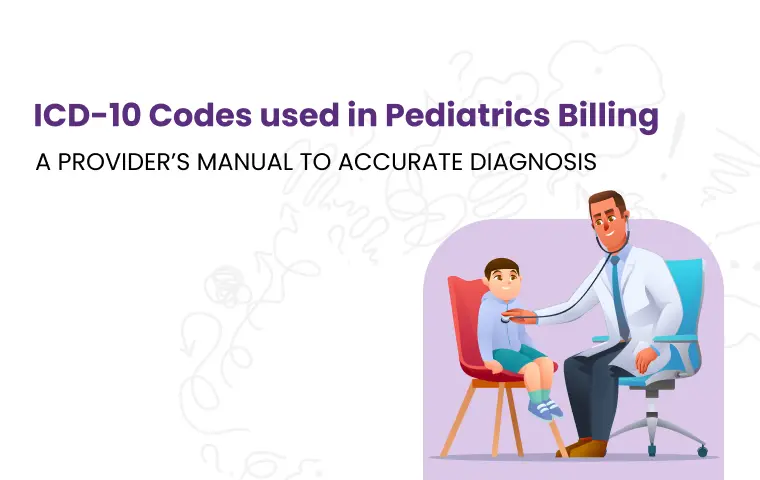Getting acquainted with diagnosis codes is a necessary step for every healthcare provider, but recalling the precise code during a patient encounter can be a challenging task. With over 500 ICD-10 codes specific to pediatrics, the challenge for healthcare providers lies in selecting the correct code during fast-paced patient encounters.
Pediatric billing demands a thorough understanding of these codes to ensure accuracy and compliance. This guide condenses the essentials, providing a practical resource for mastering pediatric ICD-10 coding.
Most Common ICD 10 For Pediatric Billing
From routine ailments like ear infections and respiratory illnesses to developmental delays and chronic conditions, these codes form the backbone of pediatric practice billing. This section highlights the most commonly used pediatric ICD-10 codes, providing a quick reference to streamline your documentation
Respiratory Conditions
Respiratory conditions are among the most frequent diagnoses in pediatric care, reflecting the unique vulnerabilities of children to infections and environmental factors.

J20.9: Acute bronchitis, unspecified.
This code is frequently used in children presenting with coughing, wheezing, or difficulty breathing caused by viral infections.
J21.9: Acute bronchiolitis, unspecified.
Often affecting infants and young children, this code captures cases of viral bronchiolitis, typically caused by RSV (Respiratory Syncytial Virus).
J02.9: Acute pharyngitis, unspecified.
Commonly used for children with sore throats resulting from viral or bacterial infections.
J05.0: Acute obstructive laryngitis (croup).
Specific to pediatric patients, this code is used for cases of croup, characterized by a distinctive barking cough and stridor.
J45.909: Unspecified asthma, uncomplicated.
This code addresses pediatric asthma cases that require ongoing management and monitoring.
Feeding problems of newborn
Feeding problems in newborns are a critical aspect of neonatal care, often requiring careful assessment and intervention to address issues that can affect growth, development, and overall health.
P92.0: Vomiting of newborn
This code is used when a newborn exhibits frequent or severe vomiting, which may be a sign of underlying gastrointestinal or metabolic disorders.
P92.1: Regurgitation and rumination of newborn
Applicable for conditions where a newborn regurgitates food without apparent discomfort or engages in repetitive chewing and re-swallowing behavior, often requiring nutritional and behavioral assessments.
P92.2: Slow feeding of newborn
Used for newborns who take an unusually long time to feed, often linked to weak sucking reflexes, prematurity, or oral-motor coordination issues.
P92.3: Underfeeding of newborn
Indicates inadequate intake of nutrition, whether due to feeding difficulties, caregiver challenges, or underlying medical conditions, necessitating close monitoring and intervention.
P92.4: Overfeeding of newborn
Assigned when a newborn consumes excessive amounts of milk or formula, potentially leading to complications such as vomiting, diarrhea, or excessive weight gain.
P92.5: Neonatal difficulty in feeding at breast
Specifically for newborns struggling to breastfeed effectively due to latch issues, low milk supply, or anatomical challenges, such as tongue-tie.
P92.6: Failure to thrive in newborn
A critical diagnosis code used for newborns who fail to gain weight or grow as expected, often requiring a multidisciplinary approach to determine underlying causes.
P92.8: Other feeding problems of newborn
A catch-all code for feeding problems not explicitly covered by other P92 codes, including rare or complex feeding issues that may require specialist input.
P92.9: Feeding problem of newborn, unspecified
This code is used when a feeding problem is present but lacks specificity or when the cause has not been identified during initial evaluation.
Nonspecific Symptoms Peculiar to Infancy
Infants often present with nonspecific symptoms that can be difficult to interpret due to their limited ability to express discomfort or specific issues.
R68.11: Excessive crying of infant (baby)
This code is used when an infant exhibits prolonged periods of crying without an identifiable cause, often referred to as colic.
R68.12: Fussy infant (baby)
Applicable when an infant shows signs of irritability or fussiness that are not attributed to a specific medical condition.
R68.13: Apparent life-threatening event in infant (ALTE)
This code is assigned when an infant experiences an episode characterized by a combination of apnea, color change, muscle tone alteration, choking, or gagging, which is alarming to the caregiver.
R68.19: Other nonspecific symptoms peculiar to infancy
This is a catch-all code for other undefined symptoms in infants that do not fit into the above categories.
Diseases of the Digestive System
K59.00: Constipation, unspecified
This is the general code used when constipation is diagnosed but the exact cause or type is not specified.
K59.01: Slow transit constipation
Used for cases where the constipation is due to delayed movement of stool through the colon.
K59.02: Outlet dysfunction constipation
Applied when the constipation results from difficulty in stool evacuation due to pelvic floor dysfunction or related issues.
Benign and Innocent Cardiac Murmurs
Benign and innocent cardiac murmurs are common findings in pediatric care, often detected during routine checkups. These murmurs are caused by normal blood flow through the heart or vessels and do not indicate structural or functional heart abnormalities. While they are typically harmless and require no intervention, accurate coding and documentation are essential to distinguish them from pathological murmurs that might warrant further investigation.
ICD-10 Codes for Benign and Innocent Cardiac Murmurs
The ICD-10-CM provides specific codes to document these murmurs:
-
R01.0: Benign and innocent cardiac murmurs This code is used for murmurs that are non-pathological and do not signify any underlying cardiac disease. These murmurs often occur in healthy children during periods of rapid growth or increased cardiac output.
-
R01.1: Cardiac murmur, unspecified Applied when a murmur is detected but further evaluation is needed to classify it as benign or pathological. This code may be used as an interim diagnosis before additional diagnostic procedures are conducted.
-
R01.2: Other cardiac sounds This catch-all code includes heart sounds not classified as benign murmurs but also not linked to specific cardiac abnormalities, such as clicks or rubs.
Short Stature
Short stature in children is a common concern in pediatric practice and can be a result of genetic predisposition, endocrine disorders, or other underlying medical conditions. Proper coding and documentation are essential to identify the cause and guide appropriate treatment or referral.
ICD-10 Code for Short Stature
-
R62.52: Short stature (childhood)
This code is used to document cases of short stature in children where the condition is evident but the underlying cause may not yet be determined.
Other Disturbances of Temperature Regulation of Newborn
Temperature regulation in newborns is a delicate process due to their limited ability to adapt to environmental changes. Disturbances in temperature regulation can signal underlying health issues or result from external factors, necessitating accurate documentation for proper diagnosis and management. The ICD-10-CM codes, as outlined by the American Academy of Professional Coders (AAPC), provide specific classifications for these conditions.
Other Disturbances of Temperature Regulation in Newborns
-
P81.0: Hypothermia of newborn
Used for cases where a newborn's body temperature falls below the normal range, often due to prematurity, sepsis, or exposure to cold environments. -
P81.1: Hyperthermia of newborn
Applies to situations where a newborn's body temperature rises above normal, potentially caused by infections, dehydration, or overheating. -
P81.2: Other specified disturbances of temperature regulation of newborn
This code captures other temperature regulation issues not classified as hypothermia or hyperthermia, such as transient temperature instability. -
P81.9: Disturbance of temperature regulation of newborn, unspecified
Used when a newborn presents with temperature regulation issues, but the specific condition has not yet been determined.
Final Words
ICD-10 coding for pediatrics doesn’t have to be complicated. With this guide, you have the roadmap to handle the most common and critical codes with ease. From respiratory conditions to newborn feeding challenges, every code you use translates into better billing accuracy and seamless workflows.
But it’s more than just numbers—accurate coding helps you tell the complete story of your patients’ care. By applying these codes effectively, you’re improving documentation, optimizing reimbursement for pediatric billing, and ultimately giving your young patients the care they deserve. The next step? Start implementing these codes today and see the difference it makes for your practice. If you think you need help consider outsourcing your pediatric billing to HMS USA LLC now!
ABOUT AUTHOR

Pedro Collins
As a blog writer with years of experience in the healthcare industry, I have got what it takes to write well-researched content that adds value for the audience. I am a curious individual by nature, driven by passion and I translate that into my writings. I aspire to be among the leading content writers in the world.
